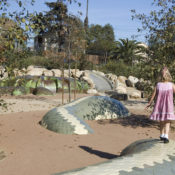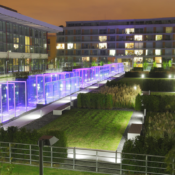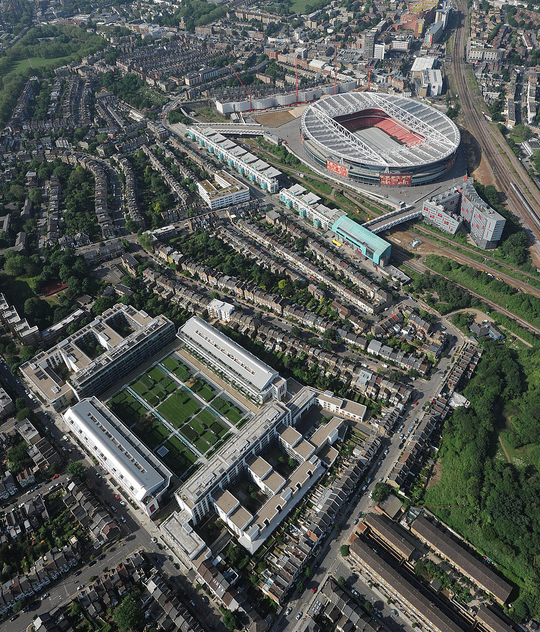Author: Jeff Gonot
April: National Landscape Architecture Month
Vista Hermosa Park, Los Angeles, CA
We gravitate toward landscape architecture for many different reasons. Some enjoy horticulture and some are intrigued by the creative process involved. Whatever the reasons we all love landscape architecture, many people are still unaware that the profession exists. Luckily, April is National Landscape Architecture Month, and ASLA Chapters across the nation and other associations around the world are taking part in bringing greater awareness of the profession to everyone.
As in previous years, landscape architects across the country plan to educate the public by hosting events, doing hands-on work in communities, having speaking engagements, and organizing and participating in design charettes.
 Central Park at Playa Vista, CA
Central Park at Playa Vista, CA
This year’s theme is Healthy Living Through Design. ASLA is challenging landscape architects to show what we’re doing to improve lives through landscape architecture. This theme connects to ASLA’s Year of Public Service, in which the organization is asking professionals to give their time and resources in a big push to help communities and increase the recognition of landscape architecture. ASLA’s Year of Public Service blog addresses some of the issues regarding this year’s theme, suggests ideas for getting involved, and will share success stories.
ASLA’s National Landscape Architecture Month website is the best resource for finding out what’s going on in your region in April. But make sure to share your Landscape Architecture Month stories with the Land8 network, via this website, Twitter, Facebook, and Instagram.
Happy National Landscape Architecture Month!
 Roof Top, Art Center College of Design, Pasadena, CA
Roof Top, Art Center College of Design, Pasadena, CA
Biomimicry: Using Nature’s Genius for Human Innovation
Nature possesses the ability to adjust and morph to the ever changing environment. We have managed to present Mother Nature with a few road blocks, but nature has found ways to progress past the wounds that we have made. Only in recent years have people tried to reverse the effects we have had on our environment. It is in these attempts at solving human problems that bring about the concept of biomimicry. More after the jump…
What (the heck) is biomimicry?
“Biomimicry or biomimetics is the examination of nature, its models, systems, processes, and elements to emulate or take inspiration from in order to solve human problems. The term biomimicry and biomimetics come from the Greek words bios, meaning life, and mimesis, meaning to imitate.” In simpler terms, biomimicry is the conscious emulation of nature’s genius.
What can nature teach us?
A lot. Here are some examples of ways nature has provided solutions to human problems:
- Natural Forms: Look at a nautilus hemishell. It shows the camerae in a logarithmic spiral. That form has been a significant inspiration for some of the greatest inventors and scientists. The spiral was first described by Descartes and later investigated by Bernoulli who is best known for his probability theory to games of chance.
- Swarm Theory: Also known as swarm intelligence (SI) can be identified in nature through the movement of a school of fish for example. The theory states it as “the collective behavior of decentralized, self-organized systems, natural or artificial.” The concept is used in work on artificial intelligence. So what we see today applied in robotics and A.I. is a function of the natural occurrence of animals, organisms moving together in schools of fish, herds of animals, and colonies of ants.
- Learning How to Heal Ourselves: One-quarter of all modern medicines are derived directly from plants, and there are hundreds of thousands of other plant species yet to examine, each with dozens of unique chemical compounds that could prove of medicinal value. If one wanted to discover more valuable medicines, where would one start looking? It could take millions of years, literally, to sort through this enormous variety of plants and plant compounds to find ones with medicinal value. Fortunately, this is exactly what researchers have discovered that chimpanzees (Pan spp.) have already done, over millions of years of evolutionary time. By observing how chimps and other species cope with illness, researchers have acquired leads on plants with promising medical applications to human health. Trees from the Vernonia genus, for example, which chimpanzees regularly seek out when ill, have been found to contain chemical compounds that show promise in treating parasites such as pinworm, hookworm, and giardia in humans.
How has biomimicry been implemented in the built environment?
The implementation of biomimicry can be seen and used in a myriad of forms, but the most pronounced of them is architecture and product/industrial design. This is not only a daily experience, but a minute to minute experience. We find ourselves coming in contact with the built environment (the spaces and places we live and move through) and the things/objects we constantly use like the computer, cell phone, touthbrush, car, and so on.
In regards to architecture and the built environment, the forms we traditionally see in modern contemporary architecture are more revealing of nature’s various forms. The works of Frank Gehry and Santiago Calatrava are perfect examples of architecture that use elements derived from nature to inform design and function. Here are four examples below:
1. Milwaukee Art Museum – Calatrava
2. TGV Exupery Train Station, Lyon – Calatrava
3. Experience Music Project, Seattle – Frank Gehry
4. Disney Concert Hall, Los Angeles – Frank Gehry
How can we and how have we already applied biomimicry to landscape architecture?
Biomimicry introduces the pre-existing natural processes, as implemented to physical items and places that cause daily problems. One could say the fluctuation in global temperatures is a problem today and will continue to be if humans don’t change their ways. As a means to reduce this problem, we have brought the integration of the landscape into the urban spaces of our city’s. This has been a more recent phenomenon and would include green roofs, which help reduce the heat island effect and ultimately the process of our planet’s warming. Introducing the landscape to concrete jungles and architecture is an example of nature’s genius put to use.
After the events of Superstorm Sandy and other natural disasters, biomimicry has played a major role in city planning and design in waterfront locations. A New York Times article showcases the numerous ways that biomimicry is being used in architecture, urban design, and landscape architecture.
Life creates conditions conducive to life. We thank you Mother Nature for toughing it out.
What examples of biomimicry have you seen in landscape architecture? How might we push further the concept of biomimicry in the profession?
Thanks for reading!

Sources
Highbury Square: From Stadium to Apartments
With the Olympics and the Euro Cup in the rear view mirror, the world looks on to other sporting events and sports in general to fill the gap. One sport in particular that is the most popular around the world, soccer, has some of the most architecturally striking stadiums. Highbury Stadium, where Arsenal Football Club of London played before moving to the Emirates Stadium in 2006, has created a unique place in North London by taking the old stadium and transforming it into luxury apartments and usable public space.
Highbury Stadium “was originally constructed in 1913 and designed by Archibald Leitch as Arsenal Stadium in the Art Deco style familiar to Arsenal supporters. It remained the home of Arsenal for 93 years until 2006.”
Many aspects of the stadium were salvaged and used to build the frame work of the apartment complex.
Design critics alike have praised the complex, saying there is “a feeling of openness and nature” while also providing “protection and privacy”. In 2009, Highbury Square’s design won the MIPIM Special Jury Award.
As an Arsenal supporter it is a revelation to see a sports club commit to such an endeavor. Joga bonita!
Sources:
- 1
- 2
















